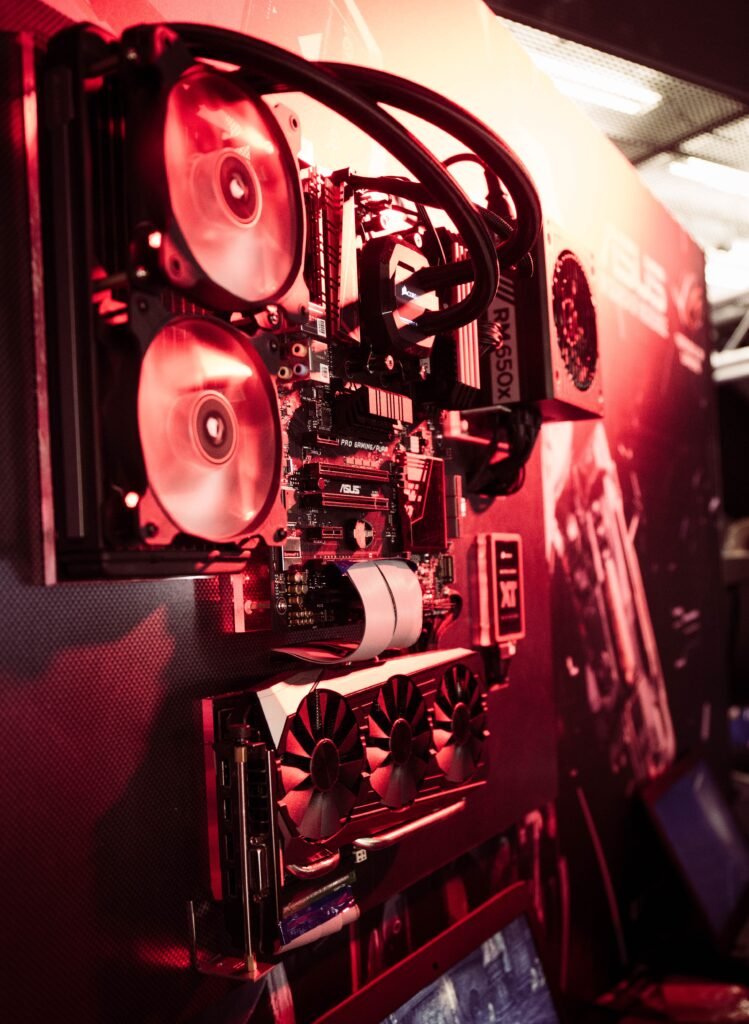Artificial intelligence, a term that often sparks images of futuristic robots and intelligent machines, has been a topic of fascination for decades. But what has truly propelled the recent surge in AI advancements? Well, the answer lies in the remarkable progress made in three key areas: GPUs, storage, and big data. GPUs, or graphics processing units, have revolutionized the way machines process and analyze data, allowing for faster and more efficient computations. Similarly, advancements in storage technology have ensured that massive amounts of data can be stored and accessed easily, fueling the development of AI algorithms. And let’s not forget about big data – the abundance of information available today has provided AI systems with the necessary raw materials to learn and improve. As a result, AI has made impressive strides, with applications ranging from driverless cars to personalized healthcare. It’s an exciting time for AI, as the integration of GPUs, storage, and big data continues to bring us closer to the realm of science fiction.

The Influence of GPUs on the Recent Boom in Artificial Intelligence
Introduction to GPUs and their role in AI
Artificial intelligence (AI) has experienced a remarkable boom in recent years, thanks in large part to advancements in GPU (Graphics Processing Unit) technology. GPUs are specialized hardware components designed to handle complex and parallel computations, making them ideal for accelerating AI algorithms. While AI has been around since the 1950s, it wasn’t until the rise of GPUs that it truly began to reach its full potential. These powerful processors have revolutionized the way AI systems process and analyze data, leading to significant improvements in performance and efficiency.
Advancements in GPU technology
Over the years, the capabilities of GPUs have greatly evolved, allowing for more sophisticated and complex AI applications. The development of high-performance GPUs with increased memory bandwidth and processing power has enabled AI models to handle larger datasets and perform more complex computations. Additionally, the integration of specialized AI-oriented features, such as Tensor Cores, into modern GPUs has further enhanced their ability to accelerate AI workloads. These advancements in GPU technology have significantly contributed to the rapid advancement and adoption of AI across various industries.
The impact of GPUs on AI performance
The utilization of GPUs in AI has had a profound impact on performance. By harnessing the parallel processing capabilities of GPUs, AI algorithms can perform multiple computations simultaneously, resulting in faster training and inference times. This has allowed researchers and developers to iterate and experiment more quickly, accelerating the pace of AI advancements. Furthermore, the ability of GPUs to handle large amounts of data and complex computations has paved the way for the development of more accurate and robust AI models. As a result, GPUs have greatly improved the overall performance and efficiency of AI systems, making them indispensable in the field of artificial intelligence.
The Role of Storage in the Recent Boom in Artificial Intelligence
Introduction to storage and its importance in AI
When discussing the recent boom in artificial intelligence, it is essential to highlight the significant role that storage technology plays in enabling AI applications. Storage refers to the devices and technologies used to store and retrieve data. In the context of AI, the ability to efficiently store and access vast amounts of data is crucial for training and deploying AI models. This data can include various types of information, such as images, videos, text, and sensor data. Without adequate storage capabilities, the processing and retrieval of data required for AI tasks would be severely limited.
Advancements in storage technology
The advancements in storage technology have been instrumental in driving the recent growth of AI. Traditional storage solutions, such as hard disk drives (HDDs), have been gradually replaced by solid-state drives (SSDs), which offer significantly faster data access speeds and improved reliability. SSDs are particularly well-suited for AI workloads, as they can handle the large volumes of data that need to be processed and stored. Additionally, the emergence of cloud-based storage platforms has provided increased accessibility and scalability for AI applications. Cloud storage enables seamless collaboration and data sharing among researchers and developers, further fueling advancements in the field.
The impact of storage on AI capabilities
The availability of fast and reliable storage solutions has played a vital role in expanding the capabilities of AI systems. The ability to store massive datasets has allowed AI models to learn and generalize from a broad range of examples, improving their accuracy and performance. Moreover, the rapid retrieval of data from storage facilitates real-time decision-making in AI applications, such as autonomous vehicles and natural language processing. As storage technology continues to advance, AI systems will be able to handle even larger datasets and perform more complex tasks, further pushing the boundaries of what is possible in the field of artificial intelligence.
The Significance of Big Data in the Recent Boom in Artificial Intelligence
Introduction to big data and its relevance to AI
In recent years, the term “big data” has become increasingly synonymous with the rapid growth of artificial intelligence. Big data refers to large and complex datasets that cannot be easily managed and analyzed using traditional data processing methods. AI systems heavily rely on big data to train and improve their models. By leveraging the abundance of data available today, AI algorithms can learn patterns, make predictions, and gain valuable insights at an unprecedented scale. The increasing availability of big data has fueled the recent boom in artificial intelligence and opened up endless possibilities for innovation.
The role of big data in machine learning
Machine learning, a subset of AI, revolves around the concept of algorithms learning from data. Big data serves as the lifeblood of machine learning algorithms, providing the necessary input to train and refine AI models. It allows algorithms to detect patterns, make predictions, and adapt to changing circumstances. The larger and more diverse the dataset, the more accurate and robust the resulting AI model becomes. Big data enables machine learning algorithms to uncover hidden patterns, discover new correlations, and make informed decisions, ultimately driving advancements in AI capabilities.
The impact of big data on AI advancements
The availability and utilization of big data have profoundly impacted the development and deployment of AI systems. The tremendous amount of data being generated from various sources, such as social media, sensors, and online platforms, provides an unprecedented opportunity for AI algorithms to learn and improve. With big data, AI models can be trained on vast amounts of examples, enabling them to recognize patterns, understand natural language, and perform complex tasks with high accuracy. As big data continues to grow, AI will continue to evolve, unlocking new possibilities and applications in fields such as healthcare, finance, and transportation.
Understanding Artificial Intelligence and its Relation to Machine Learning
Introduction to artificial intelligence and machine learning
Artificial intelligence (AI) is a broad concept encompassing the development of machines capable of mimicking human intelligence. It involves the creation of systems that exhibit traits like reasoning, problem-solving, learning, and decision-making. Machine learning, on the other hand, is a subset of AI that focuses on algorithms learning from and making predictions or determinations based on data. Machine learning algorithms are designed to automatically improve and adapt their performance without explicit programming, making them a fundamental component of AI.
Differentiating between AI and machine learning
While AI encompasses various techniques and approaches, machine learning represents a specific method within the AI umbrella. AI can include rule-based systems, expert systems, and other approaches, while machine learning emphasizes the ability to learn from data and improve performance over time. Machine learning algorithms can analyze vast amounts of data, identify patterns, and make predictions or decisions based on that knowledge. AI, on the other hand, involves the broader concept of creating intelligent machines capable of performing complex tasks and exhibiting human-like intelligence and behavior.
The role of machine learning in the recent AI boom
Machine learning has played a pivotal role in the recent boom of artificial intelligence. The availability of vast amounts of data and advancements in processing power and algorithms have led to significant breakthroughs in machine learning techniques. ML algorithms, such as deep learning, have demonstrated exceptional performance in tasks such as image recognition, natural language processing, and speech synthesis. The ability of machine learning algorithms to continuously learn and improve from data has greatly influenced the advancement and adoption of AI in various industries, contributing to the current AI revolution.

Deep Learning: A Revolutionary Technique in Machine Learning
Introduction to deep learning
Deep learning is a revolutionary technique within the field of machine learning that has gained considerable attention and popularity in recent years. It involves training artificial neural networks with multiple layers to process and learn from large amounts of data. Inspired by the structure and functionality of the human brain, deep learning algorithms excel at recognizing patterns, understanding complex relationships, and making accurate predictions. Its ability to automatically extract high-level features from raw data without the need for explicit feature engineering sets deep learning apart from other machine learning techniques.
Explanation of neural networks and multiple layers
At the heart of deep learning are artificial neural networks, mathematical models composed of interconnected nodes, or “neurons.” Each neuron takes in input, performs a computation, and produces an output. In deep learning, these neural networks consist of multiple layers, known as deep neural networks. Each layer extracts and refines different features from the input data, passing them on to the subsequent layers. The hierarchical structure of deep neural networks enables them to automatically learn complex representations and capture intricate patterns in the data, achieving state-of-the-art performance in various tasks.
Benefits and applications of deep learning
Deep learning has revolutionized machine learning by outperforming traditional algorithms in areas such as image classification, speech recognition, natural language processing, and more. Its ability to process large amounts of data and extract meaningful features has resulted in breakthroughs across various industries. For example, in healthcare, deep learning is being used to detect diseases from medical images with high accuracy. In autonomous driving, it enables vehicles to understand their surroundings and make informed decisions. Deep learning has also improved the accuracy of recommendation systems, spam filters, and many other applications, making it a transformative technique within the field of machine learning.
The Practical Applications of Narrow AI
Differentiating between general AI and narrow AI
Artificial intelligence can be categorized into two main types: general AI and narrow AI. General AI refers to machines or systems that possess human-like intelligence and abilities, capable of performing any intellectual task that humans can do. Narrow AI, on the other hand, refers to AI systems that are designed to perform specific tasks better than humans but lacks the general intelligence found in humans. While general AI remains mostly in the realm of science fiction, narrow AI is already being deployed in various real-world applications, delivering impressive results.
Examples of narrow AI applications
Narrow AI has found its way into numerous domains and industries, showcasing its practical applications. One common example of narrow AI is image classification, where AI algorithms can accurately identify objects and categorize them based on provided training data. Another example is facial recognition technology, which has been widely deployed in areas such as security systems, digital identity verification, and social media platforms. Virtual personal assistants, such as Siri and Alexa, are also instances of narrow AI, providing users with helpful information, reminders, and answering questions.
Advantages and limitations of narrow AI
Narrow AI offers several advantages over general AI. By focusing on specific tasks, narrow AI systems can deliver superior performance and accuracy compared to humans. They can process vast amounts of data quickly, recognize intricate patterns, and make precise predictions, all while operating at scale. Narrow AI also presents an opportunity for specialization, allowing developers to create AI systems tailored to particular domains or applications. However, narrow AI also has its limitations. These systems lack the ability to generalize beyond the specific tasks they are designed for and do not possess the comprehensive understanding and learning capabilities of humans.

The Process of Machine Learning
Introduction to machine learning
Machine learning is a subset of artificial intelligence that involves training machines with algorithms and data to make predictions or determinations about the world. The process of machine learning revolves around providing a machine with training data, allowing it to understand patterns and relationships within the data through statistical techniques. By iteratively adjusting its internal parameters, a machine learning model improves its performance over time, enabling it to make accurate predictions or decisions when presented with new, unseen data.
Overview of the training process
The training process in machine learning typically involves several steps. First, a dataset is collected, consisting of input data and corresponding output labels or target values. This dataset is divided into two parts: the training set and the validation set. The model is then initialized with random parameters and trained using the training set. During training, the model adjusts its internal parameters based on the differences between its predictions and the actual target values. This process, known as optimization or learning, aims to minimize the error or loss between the predicted and actual values. The trained model is then evaluated using the validation set to ensure its performance is satisfactory.
Types of machine learning algorithms
Machine learning algorithms encompass a wide range of techniques, each suited for different types of problems and data. Some common types of machine learning algorithms include:
- Supervised Learning: In this type of learning, the algorithm is given labeled examples to learn from. It learns the relationship between inputs and outputs, allowing it to make predictions on new, unseen data.
- Unsupervised Learning: Unsupervised learning algorithms analyze unlabeled data to discover patterns or relationships without guidance. This type of learning is often used for clustering, dimensionality reduction, and anomaly detection.
- Reinforcement Learning: Reinforcement learning involves training an agent to interact with an environment and learn the optimal actions through trial and error. The agent receives feedback in the form of rewards or penalties based on its actions, enabling it to improve its decision-making abilities.
The choice of machine learning algorithm depends on the nature of the problem, the available data, and the desired outcome.
The Role of Deep Learning in Advancing AI
Introduction to deep learning and its relation to AI
Deep learning, a subset of machine learning, has emerged as a leading technique in advancing the field of artificial intelligence. Deep learning models are built upon artificial neural networks with multiple layers, enabling them to process and learn from large volumes of data. By emulating the structure and functionality of the human brain, deep learning models excel at recognizing patterns, understanding complex relationships, and making accurate predictions. Deep learning plays a vital role in pushing the boundaries of AI, enabling breakthroughs in areas such as computer vision, natural language processing, and robotics.
Advancements in deep learning technology
Recent advancements in deep learning technology have revolutionized the field of artificial intelligence. One key advancement is the development of more sophisticated neural network architectures, such as convolutional neural networks (CNNs) for image analysis and recurrent neural networks (RNNs) for sequential data processing. These architectures allow deep learning models to learn increasingly complex representations and extract high-level features from raw data. Additionally, the availability of large-scale labeled datasets, such as ImageNet and COCO, has facilitated the training of deep learning models, leading to improved performance and accuracy.
Real-world applications of deep learning in AI
Deep learning has witnessed remarkable success in various real-world applications, driving advancements in AI. In computer vision, deep learning models have achieved human-level performance in tasks like image classification, object detection, and facial recognition. Natural language processing has also benefited from deep learning, with models capable of language translation, sentiment analysis, and question answering. Robotics and autonomous systems have seen significant advancements through deep learning, enabling tasks such as autonomous navigation, grasping objects, and speech synthesis. These practical applications demonstrate the immense potential of deep learning in advancing AI across a range of industries.

Practical Applications of Deep Learning in Various Fields
Impact of deep learning on driverless cars
One of the most prominent applications of deep learning is in the field of autonomous vehicles, where deep learning models have revolutionized perception and decision-making tasks. Deep neural networks, such as CNNs, are used to process input from sensors such as cameras and lidar, enabling the vehicle to understand and interpret its surroundings. By learning from vast amounts of labeled data, deep learning models can accurately detect objects, predict their behavior, and make informed decisions in real-time. The advancements in deep learning have propelled the development of fully autonomous cars, bringing us closer to a future where driverless transportation is a reality.
Utilizing deep learning for preventive healthcare
Deep learning has significant potential for improving healthcare outcomes through preventive measures. By leveraging large-scale medical datasets, deep learning models can accurately predict and identify early signs of diseases. For example, deep learning algorithms can analyze medical images, such as X-rays and MRIs, to detect abnormalities or tumors with high accuracy. Deep learning can also be applied to genetic data analysis, helping identify individuals at higher risk for certain diseases. The early detection and prevention of diseases through deep learning not only improves patient outcomes but also reduces healthcare costs, making it a critical application within the healthcare industry.
Enhancing movie recommendations through deep learning
Deep learning has had a significant impact on the entertainment industry, particularly in recommender systems. Platforms like Netflix and Amazon Prime leverage deep learning models to analyze user preferences, viewing history, and feedback to make personalized movie recommendations. By learning from vast amounts of user data, deep learning models can understand complex patterns and make accurate predictions on users’ movie preferences. This enhances user satisfaction, helps discover new content, and drives greater engagement. Deep learning-driven recommendation systems have become a critical component of modern entertainment platforms, contributing to improved user experiences.
The Future of Artificial Intelligence with Deep Learning
Closing the gap between science fiction and AI
Deep learning has propelled artificial intelligence into realms once thought to be confined to science fiction. The remarkable advancements in deep learning have brought us closer to achieving the potential of AI. Tasks that were previously considered too complex or challenging for machines, such as natural language understanding, image recognition, and decision-making, are now being accomplished with high accuracy. With further advancements in deep learning technology, AI systems will continue to expand their capabilities, bridging the gap between what was once imagined and what is now becoming a reality.
Promising advancements in deep learning
The future of deep learning holds tremendous promise, with several advancements on the horizon. One area of focus is the development of more efficient and scalable deep learning architectures. Researchers are exploring methods to optimize neural networks, reduce computational requirements, and improve training efficiency. Additionally, exploring techniques such as transfer learning, where pre-trained models are adapted to new tasks, can accelerate the deployment of deep learning solutions in different domains. These advancements aim to make deep learning more accessible and applicable to a wide range of industries and use cases.
Potential implications and challenges for the future
While deep learning shows great promise, it also presents challenges and potential implications for the future. As deep learning models become more complex and powerful, there is a growing concern about their interpretability and transparency. Understanding how decisions are made within these models is essential for building trust and ensuring ethical and responsible use of AI. Additionally, the availability of vast amounts of data raises privacy and security concerns. Protecting sensitive information while harnessing the power of data for deep learning remains an ongoing challenge. Addressing these challenges will be crucial for further advancements and widespread adoption of deep learning in the future.







